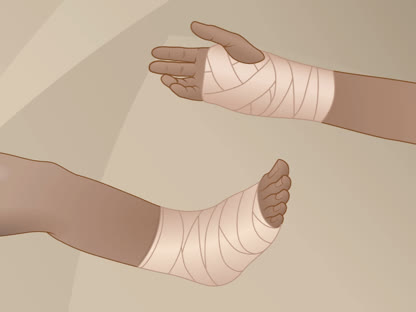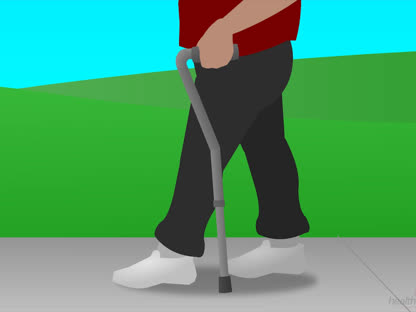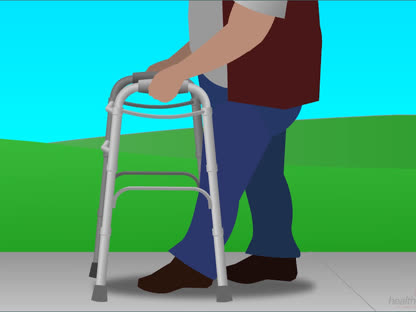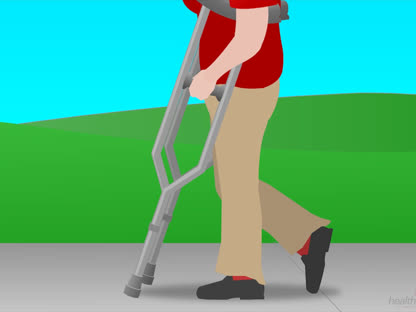Ankle Sprain
Condition Basics
What is an ankle sprain?
An ankle sprain is an injury that happens when you stretch or tear the ligaments in your ankle. Most sprains happen when you twist your ankle. Afterward, the ankle usually becomes swollen and painful.
Even though ankle sprains are common, they aren't always minor injuries. Some people with repeated or severe sprains can develop long-term joint pain and weakness. Treating a sprained ankle can help prevent ongoing ankle problems.
What are the symptoms?
With most ankle sprains, you feel pain right away. Often the ankle starts to swell and bruise, and it hurts to move it. If a sprain is more severe, you may have a lot of pain. You may not be able to walk or put weight on your foot.
How is it diagnosed?
Your doctor will ask how you hurt your ankle and if you've hurt your ankle before. You'll be asked to move your foot up and down and to try to walk. Then the doctor will carefully move your foot and ankle to see if the ligaments work and what causes pain.
How is an ankle sprain treated?
At first, you may be able to treat your sprained ankle with the RICE approach. RICE stands for R est, I ce, C ompression, and E levation. You may also need pain medicines and rehab exercises. In more serious cases, surgery may be needed.
What kind of a rehabilitation program should you follow?
Most people can start rehab right away. Your doctor will recommend specific exercises, depending on your level of pain. A combination of stretching, strength, and balance exercises may help the ankle heal totally and may prevent further injury.
Health Tools
Health Tools help you make wise health decisions or take action to improve your health.
Symptoms
With most ankle sprains, you feel pain right away at the site of the tear. Often the ankle starts to swell right away and may develop bruising. The ankle area is usually tender to touch, and it hurts to move it.
In more severe sprains, you may hear and/or feel something tear, along with a pop or snap. You will probably have extreme pain at first and won't be able to walk or even put weight on your foot. Usually, the more pain and swelling you have, the more severe your ankle sprain is and the longer it will take to heal.
When to Call a Doctor
Call your doctor now or seek medical care if:
- Your ankle looks different than normal.
- Your pain is getting worse.
- Your swelling is getting worse.
- You are unable to put weight on your foot.
Watch closely for changes in your health, and be sure to contact your doctor if you are not getting better after 1 week.
If your pain is mild and you are able to put some weight on your foot, you can treat your sprain at home. Early treatment followed by rehabilitation exercises can help your ankle heal properly.
Exams and Tests
Your doctor will ask you how the injury occurred and if you have hurt your ankle before. The doctor will check your foot and ankle, your lower leg, and even your knee to see if you are hurt anywhere else. The doctor may ask you to move your foot up and down and to take a few steps if you can.
In some cases, the doctor may order X-rays to be sure there isn't a broken bone in the ankle or the foot. Children often have X-rays so the doctor can check for any damage to the bone's growth plate.
Learn more
Treatment Overview
Early treatment for an ankle sprain is called the RICE approach:
- Rest. You may need to use crutches until walking isn't painful without them.
- Ice. Put ice or a cold pack on your ankle for 10 to 20 minutes at a time. Try to do this every 1 to 2 hours for the next 3 days (when you are awake). Put a thin cloth between the ice and your skin.
- Compression. An elastic compression wrap will help decrease swelling. Wear it for the first 24 to 36 hours. A protective brace should also be worn if you try to bear weight on your injured ankle. Don't apply the wrap too tightly. Loosen the bandage if it gets too tight. Signs that the bandage is too tight include numbness, tingling, increased pain, coolness, or swelling in the area below the bandage. Compression wraps don't protect your ankle, but they do remind you to be careful of your ankle.
- Elevation. Raise your ankle above the level of your heart for 2 to 3 hours a day if you can. This can decrease swelling and bruising.
For pain, you can try an over-the-counter medicine like acetaminophen, ibuprofen, or naproxen. Be safe with medicines. Read and follow all instructions on the label.
It may help to wear hiking boots or other high-top, lace-up shoes for support. But be careful. Don't force your foot into a boot if you feel a lot of pain or discomfort. For severe sprains, you can try a splint or brace.
Your doctor may suggest that you keep some or all of your weight off your ankle as it heals. If so, learn to use your crutches or your walker properly and safely.
After the early swelling and pain decrease, rehab exercises can help to make sure your ankle heals right, prevent reinjury, and avoid ongoing problems.
Almost all ankle sprains heal on their own with proper home treatment and rehab exercises.
Surgery to repair torn ligaments is usually only considered when there is a severe ligament tear (or tears) or if the ankle is still unstable after rehab. Surgery may also be an option if you have broken a bone.
Learn more
Watch
Self-Care
Ankle sprains take an average of 6 weeks to heal. But a sprain can take 12 weeks or more to heal. It depends on how bad it is.
An ankle brace, air stirrup, hiking boot, high-top shoe or boot, or another form of ankle support should be worn to protect the ligaments as your ankle heals. After the ankle is healed, wearing an ankle brace or taping the ankle may help prevent reinjury.
For more painful and severe sprains, you might be able to bear some weight while using crutches and a protective brace, such as a brace with a built-in air cushion or another form of ankle support. Follow your doctor's instructions on how much weight you can put on your ankle.
If your doctor or physical therapist gives you ankle exercises to do, be sure to do them exactly as instructed.
Some people who have repeated or severe sprains can develop long-term joint pain and weakness. Treating a sprained ankle can help prevent ongoing ankle problems.
Physical Rehabilitation
In the case of a minor sprain, rehabilitation (rehab) exercises begin soon after the injury with walking. You can try wearing hiking boots or other high-top, lace-up shoes for support. But don't force your foot into a boot if it hurts or causes discomfort.
Stretch daily, especially before and after physical activities to prevent reinjury. Even after your ankle feels better, do rehab exercises several times a week to keep it strong.
The timing and type of rehab exercises may vary according to your doctor's or physical therapist's preferences. You'll probably do the following types of exercise.
- Range-of-motion exercises. These help you move the joint as far as you can in every direction that it moves.
- Stretching exercises. They help keep your Achilles tendon (heel cord) flexible while your ankle heals.
- Strengthening exercises. These strengthen the muscles so they help support your ankle.
- Balance and control exercises. They help your foot and ankle respond to activities. This can help prevent reinjury.
Learn more
Related Information
Credits
Current as of: July 24, 2025
Author: Ignite Healthwise, LLC Staff
Clinical Review Board
All Ignite Healthwise, LLC education is reviewed by a team that includes physicians, nurses, advanced practitioners, registered dieticians, and other healthcare professionals.
Current as of: July 24, 2025
Author: Ignite Healthwise, LLC Staff
Clinical Review Board
All Ignite Healthwise, LLC education is reviewed by a team that includes physicians, nurses, advanced practitioners, registered dieticians, and other healthcare professionals.















